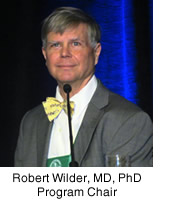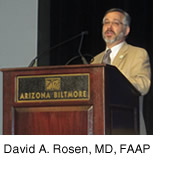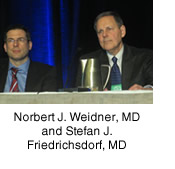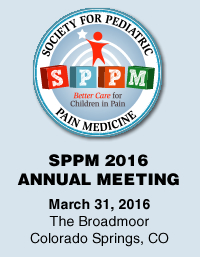Meeting Review
Society for Pediatric Pain Medicine Second Annual Meeting Review
By Kristen Spisak, MD
Dayton Children’s Hospital
Dayton, OH
 The Second Annual Meeting of the Society for Pediatric Pain Medicine (SPPM) took place on March 12, 2015 at the beautiful Arizona Biltmore Resort in Phoenix, Arizona. SPPM President Sabine Kost-Byerly, MD, FAAP (Johns Hopkins) opened the session by reporting that the first SPPM Board of Directors was successfully elected this fall and thanked everyone for their continued societal involvement. Meeting Program Chair Robert Wilder, MD, PhD (Mayo Clinic, Rochester) announced that members can now get CME and MOCA patient safety credits for their attendance and thanked Rita Agarwal, MD, FAAP (Stanford University) for her diligent work on this matter. After this warm welcome, the SPPM meeting offered four distinct educational sessions, lunchtime PBLD discussions, and specialized afternoon workshops.
The Second Annual Meeting of the Society for Pediatric Pain Medicine (SPPM) took place on March 12, 2015 at the beautiful Arizona Biltmore Resort in Phoenix, Arizona. SPPM President Sabine Kost-Byerly, MD, FAAP (Johns Hopkins) opened the session by reporting that the first SPPM Board of Directors was successfully elected this fall and thanked everyone for their continued societal involvement. Meeting Program Chair Robert Wilder, MD, PhD (Mayo Clinic, Rochester) announced that members can now get CME and MOCA patient safety credits for their attendance and thanked Rita Agarwal, MD, FAAP (Stanford University) for her diligent work on this matter. After this warm welcome, the SPPM meeting offered four distinct educational sessions, lunchtime PBLD discussions, and specialized afternoon workshops.
 Petra Meier, MD, DEAA (Boston Children’s Hospital) moderated the first session, which included lectures about pain and sleep, followed by a panel discussion. Tonya Palermo, PhD (Seattle Children’s Research Institute) gave a fascinating lecture about the interrelationship of chronic pain and sleep disturbances. She presented that both pain modulation and sleep regulation share common inflammatory, neurochemical, and cognitive pathways. Interestingly, pain treatment does not improve sleep, but poor sleep does exacerbate both acute and chronic pain states. As such, Dr. Palermo identified sleep as a potential modifiable target when trying to prevent or interrupt the cycle of chronic pain.
Petra Meier, MD, DEAA (Boston Children’s Hospital) moderated the first session, which included lectures about pain and sleep, followed by a panel discussion. Tonya Palermo, PhD (Seattle Children’s Research Institute) gave a fascinating lecture about the interrelationship of chronic pain and sleep disturbances. She presented that both pain modulation and sleep regulation share common inflammatory, neurochemical, and cognitive pathways. Interestingly, pain treatment does not improve sleep, but poor sleep does exacerbate both acute and chronic pain states. As such, Dr. Palermo identified sleep as a potential modifiable target when trying to prevent or interrupt the cycle of chronic pain.
Next, Sapna Kudchadkar, MD (Johns Hopkins) spoke about the effect of opioids on the sleep-wake cycle. Despite their sedating properties, opioids alter both REM and non-REM sleep, both of which are integral to normal brain development during infancy and childhood. Additionally, in pediatric patients with obstructive sleep apnea, careful opioid titration is paramount given this population’s increased sensitivity to opioids and their higher propensity for sleep disturbances. To round out the first session, Suresh Kotagal, MD (Mayo Clinic, Rochester) provided an overview of commonly used non-opioid analgesics and their effects on sleep. He specifically discussed acetaminophen, ibuprofen, anti-depressants, anti-epileptics, and sleeping pills. Audience questions and a panel discussion followed these initial three lectures.
Yuan-Chi Lin, MD, MPH (Boston Children’s Hospital) moderated Session II on acute pain management. First, Terri D. Voepel-Lewis, PhD, RN (University of Michigan) addressed the topic of monitoring children during analgesic delivery. She emphasized that proper monitoring is imperative since over-sedation is commonly under-recognized and can lead to significant patient morbidity and mortality. Additionally, Dr. Voepel-Lewis reviewed monitoring with pulse-oximetry versus capnography, monitoring limitations, and comprehensive patient surveillance plans.
 John S. Jones, MD (Phoenix Children’s Hospital) next provided an overview on the use of regional anesthesia and analgesia in the private practice setting. He covered the differences between academic and private practice pain practices, challenges unique to the private practice provider, and guidelines for establishing and managing a private pediatric pain practice. To conclude the session, David A. Rosen, MD, FAAP (West Virginia University) spoke about the use of regional anesthesia and analgesia for pediatric cardiothoracic surgery. Dr. Rosen outlined the regional anesthesia benefits, goals, indications and contraindications and described specific regional anesthesia techniques for pediatric patients undergoing cardiac surgery. He also presented findings from the Rosen Database and summarized complementary therapies that he frequently uses for his cardiac patients. Audience questions and a panel discussion closed the second session, and lunch with various PBLDs followed.
John S. Jones, MD (Phoenix Children’s Hospital) next provided an overview on the use of regional anesthesia and analgesia in the private practice setting. He covered the differences between academic and private practice pain practices, challenges unique to the private practice provider, and guidelines for establishing and managing a private pediatric pain practice. To conclude the session, David A. Rosen, MD, FAAP (West Virginia University) spoke about the use of regional anesthesia and analgesia for pediatric cardiothoracic surgery. Dr. Rosen outlined the regional anesthesia benefits, goals, indications and contraindications and described specific regional anesthesia techniques for pediatric patients undergoing cardiac surgery. He also presented findings from the Rosen Database and summarized complementary therapies that he frequently uses for his cardiac patients. Audience questions and a panel discussion closed the second session, and lunch with various PBLDs followed.
 Anjana Kundu, MBBS, MD (Nationwide Children’s Hospital) opened and moderated the third session, which focused on palliative care. Stefan J. Friedrichsdorf, MD (Children’s Hospitals and Clinics of Minnesota) covered advanced pain management in pediatric palliative care and used a patient case example to illustrate a step-wise approach. Included in his multimodal armamentarium were opioid and non-opioid pain medications, adjuvant medications, integrative therapies, invasive techniques, and WHO principles. Next, Norbert J. Weidner, MD (Cincinnati Children’s Hospital) discussed regional anesthesia as part of pediatric palliative care, specifically, indications for regional techniques, patient assessment and selection, management and complications of various techniques, and ethical considerations associated with regional anesthesia and end of life care. Drs. Friedrichsdorf and Weidner then fielded questions and discussion from the audience to close the third session.
Anjana Kundu, MBBS, MD (Nationwide Children’s Hospital) opened and moderated the third session, which focused on palliative care. Stefan J. Friedrichsdorf, MD (Children’s Hospitals and Clinics of Minnesota) covered advanced pain management in pediatric palliative care and used a patient case example to illustrate a step-wise approach. Included in his multimodal armamentarium were opioid and non-opioid pain medications, adjuvant medications, integrative therapies, invasive techniques, and WHO principles. Next, Norbert J. Weidner, MD (Cincinnati Children’s Hospital) discussed regional anesthesia as part of pediatric palliative care, specifically, indications for regional techniques, patient assessment and selection, management and complications of various techniques, and ethical considerations associated with regional anesthesia and end of life care. Drs. Friedrichsdorf and Weidner then fielded questions and discussion from the audience to close the third session.
Neil Raj Singhal, MD (Mayo Clinic, Scottsdale) moderated the final session of the meeting, which consisted of the best of current pediatric pain research. Drs. Friedrichsdorf, Jones, and Palermo each presented two of the best 2014 publications on the topics of pain medications, regional anesthesia, and pediatric chronic pain, respectively. After closing remarks, members of the assembly had the opportunity to attend additional SPPM and SPA workshops.
Thus concluded the Second Annual Meeting of the Society for Pediatric Pain Medicine. As always, we learned a lot, enjoyed the warm weather, and look forward to the SPPM Third Annual Meeting, which will be held on March 31, 2016 at The Broadmoor in Colorado Springs, Colorado.

